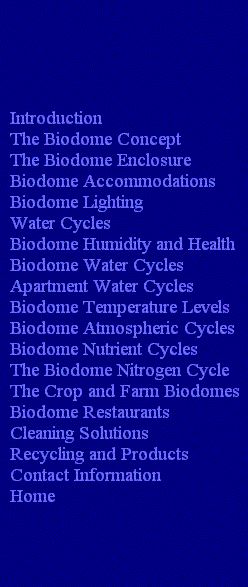
Biodome Atmospheric Cycles
Now, with regard to the atmospheric cycles of this biodome, perhaps the most important process that would occur within it would be the natural exchange of Oxygen and Carbon Dioxide that would constantly take place between the vegetation of the biodome and the people of the biodome. In this exchange, then, in order to manufacture their carbohydrates, the leaves of the vegetation in this biodome would take in the Carbon Dioxide that the people would exhale, and would then emit Oxygen into the biodome as a by-product of this process. As a result of this process, then, almost all free Oxygen within the atmosphere of this biodome would be produced by this process, and the Oxygen produced would then be inhaled by the people of the biodome for use in their biological processes.
Now, the main thing to understand about the atmosphere of this biodome is that all the gases inside any biodome will stratify according to their weight because they will have no wind to stir them around, which would leave Oxygen occupying the lowest 21% of the atmosphere where it is most needed, along with Carbon Dioxide and water vapor, which are also most needed at this level. This, in turn, would leave all the trace gases at the top of the biodome, and Nitrogen occupying the remaining 78% of the atmosphere below that.
Now, in the case of deciduous ecosystems, which produce the highest levels of Oxygen in temperate climates, because the trees in these systems would drop their leaves in the fall and cease to produce Oxygen until the springtime when new leaves would form, certain types of evergreen trees would need to be incorporated into these ecosystems so that a balance of Oxygen could be maintained during these periods. The two types of evergreen trees that would probably cure this problem the best, then, would be Magnolias and Hollies, because they not only produce an adequate level of Oxygen throughout the year, but also because, unlike other evergreens, their root systems are very shallow, just like those of deciduous trees, and this means that virtually all the vegetation of these biodomes could be planted into a relatively shallow layer of earth, and this, in turn, means that less labor and raw material would be required to create these types of biodomes, as compared to biodomes that would require deeper layers of soil.